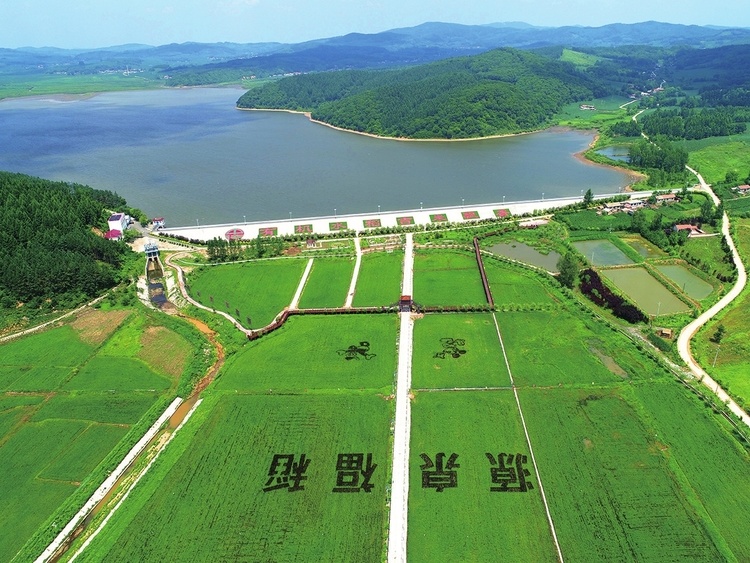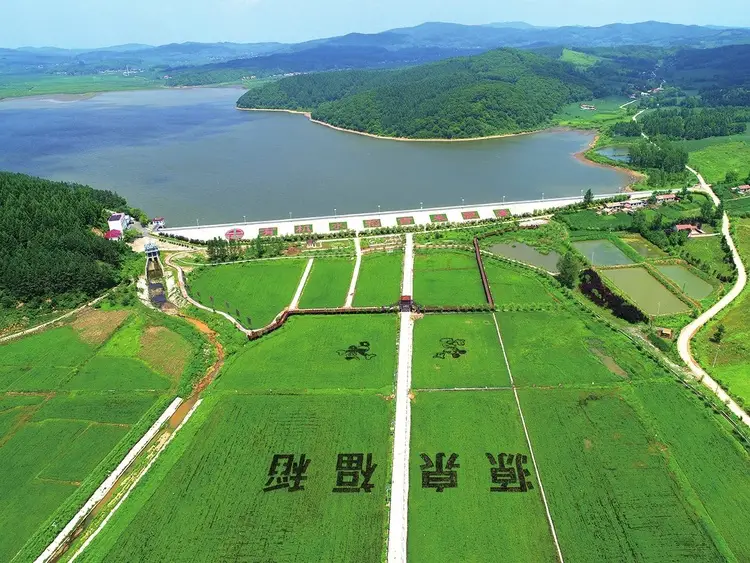By Yue Furong, Li Jiading, People’s Daily

Photo shows a picturesque reservoir on the Liaohe River and green paddy fields near the reservoir. (Photo/Jilin Daily)
“Look, there is fish in the river again,” Ji Shaogui, a local resident in Liaoyuan, Northeast China’s Jilin Province, cried excitedly during a short break from his jog along the Xianren River, a 19.3-kilometer-long river that passes through Liaoyuan city from north to south.
“I’ve lived near the river for more than ten years. It used to stink so bad that I usually covered my nose to cross the bridge over the river,” Ji told the People’s Daily. The man, who likes taking a run in the morning, frowned as he recalled the condition of the river several years ago.
As one of the main tributaries of the Dongliao River, one of the major rivers that flow through Jilin province, Xianren River has an important influence on the water quality of the Dongliao River.
As a great amount of domestic sewage had been discharged straight into the Xianren River, water quality of the river seriously deteriorated.
“It was impossible to walk the whole way along the Xianren River,” said Liu Chong, an engineer of the urban management and law enforcement bureau of Liaoyuan city.
The banks of Xianren River were dotted with illegal houses and abandoned small factories, according to Liu, who has been in charge of the technologies related to the project for treatment and improvement of the black and smelly water of Xianren River.
In recent years, Liaoyuan city has carried out comprehensive projects to treat the polluted water and restore the ecology of Dongliao River.
The city started the projects by collecting detailed information about the unapproved constructions along the banks of Xianren River, and then made a list of what to be demolished and what to be moved.
At the same time, the city invited experts to formulate a scientific plan for comprehensive treatment of the river, and launched 45 projects for the treatment of polluted water.
“We cleared as much as 130,000 cubic meters of garbage and sludge from the river,” Liu noted.
After more than two years of remediation, the roads along the banks of Xianren River have been paved with stone bricks and become clean, tidy, and accessible, while the river has taken on a brand new look. It looks bright and clear, with water plants swaying leisurely under beautiful ripples.
“The root cause of the water pollution in the Dongliao River and its tributaries lies actually on the banks,” said Yu Jian, deputy director of the Liaoyuan ecology and environment bureau.
Before the year 2018, over 50,000 tons of municipal sewage was discharged directly into the river every day, causing the water quality of Dongliao River to be rated Grade V, the worst in China’s water quality grading system, for many consecutive years.
“Rainwater and sewage were drained through the same pipe network, which could manage to work during the dry season, but was often overwhelmed in the wet season,” Yu said.
After the pressure relief devices at various parts of the pipeline automatically started, sewage was discharged to the Earth’s surface, not only polluting the living environment of citizens, but eventually flowing into rivers, Yu added.
Yu pointed out that the Dongliao River didn’t have sufficient ecological water replenishment capacity, which made it rather difficult to restore the ecology of the river once it was polluted.
In 2018, Liaoyuan city launched a project for separating the drainage systems of rainwater and sewage, planning to transform 73 kilometers of rainwater pipes and sewer lines.
So far, the city has completed the transformation of 64.16 kilometers of the pipes and realized separation of drainage systems for rainwater and sewage in 90 percent of the areas in the city.
Meanwhile, the daily capacity of the sewage treatment plants in Liaoyuan city has increased from 100,000 tons to 160,000 tons.
At present, the city is stepping up efforts to build a lift pump station at the intersection of Xianren River and Dongliao River. Upon completion this year, the station will transfer the water of Dongliao River to the upper reaches of Xianren River through a 6.6-kilometer-long return piping.
“We have also built compound channels for the Xianren River, thus maintaining the long-term stability of the water quality through water diversion and replenishment,” said Yu Fujun, deputy director of Liaoyuan municipal water conservancy bureau.
Besides treating water pollution, Liaoyuan city has also made efforts to boost ecological restoration by turning marginal farmland to forests.
“We couldn’t have enjoyed such great life without the tussah woods,” said Han Xiaoyun, a 48-year-old villager in Anbei village, Liaoheyuan township, the sourceland of Dongliao River.
“We lacked environmental protection awareness and cut down trees to grow corn, but couldn't really earn much money,” Han said.
Last year, the government of Liaoheyuan township encouraged villagers who live near the source of Dongliao River to turn marginal farmland into forests and suggested that they transfer the management right of land to companies specializing in growing forests for maintenance and improvement of ecological environment.
According to the overall planning of the Liaoheyuan township government, most of the land in Anbei village was used to grow oak woods for rearing tussahs.
Villagers doubted the idea at first, wondering where the woods would lead people.
“I searched for relevant information online. Tussahs have high economic value, and the oak trees can help preserve water and soil,” Han told her fellow villagers. She was the first in the township to sign contracts and transfer her land management right to companies.
Han transferred the management right of all 1.4 hectares of land of her family, and saw gains quickly.
Last year, Han earned more than 50,000 yuan ($7,330) by rearing tussahs and tending the trees. This year, many villagers joined her in planting oak trees for rearing tussahs, gradually turning the barren mountains near Liaoheyuan township green.
The management right of a total of 7,182 hectares of land has been transferred in Liaoyuan city in 2019, during which the city created 6,257 hectares of forests.
“I’ve lived near the river for more than ten years. It used to stink so bad that I usually covered my nose to cross the bridge over the river,” Ji told the People’s Daily. The man, who likes taking a run in the morning, frowned as he recalled the condition of the river several years ago.
As one of the main tributaries of the Dongliao River, one of the major rivers that flow through Jilin province, Xianren River has an important influence on the water quality of the Dongliao River.
As a great amount of domestic sewage had been discharged straight into the Xianren River, water quality of the river seriously deteriorated.
“It was impossible to walk the whole way along the Xianren River,” said Liu Chong, an engineer of the urban management and law enforcement bureau of Liaoyuan city.
The banks of Xianren River were dotted with illegal houses and abandoned small factories, according to Liu, who has been in charge of the technologies related to the project for treatment and improvement of the black and smelly water of Xianren River.
In recent years, Liaoyuan city has carried out comprehensive projects to treat the polluted water and restore the ecology of Dongliao River.
The city started the projects by collecting detailed information about the unapproved constructions along the banks of Xianren River, and then made a list of what to be demolished and what to be moved.
At the same time, the city invited experts to formulate a scientific plan for comprehensive treatment of the river, and launched 45 projects for the treatment of polluted water.
“We cleared as much as 130,000 cubic meters of garbage and sludge from the river,” Liu noted.
After more than two years of remediation, the roads along the banks of Xianren River have been paved with stone bricks and become clean, tidy, and accessible, while the river has taken on a brand new look. It looks bright and clear, with water plants swaying leisurely under beautiful ripples.
“The root cause of the water pollution in the Dongliao River and its tributaries lies actually on the banks,” said Yu Jian, deputy director of the Liaoyuan ecology and environment bureau.
Before the year 2018, over 50,000 tons of municipal sewage was discharged directly into the river every day, causing the water quality of Dongliao River to be rated Grade V, the worst in China’s water quality grading system, for many consecutive years.
“Rainwater and sewage were drained through the same pipe network, which could manage to work during the dry season, but was often overwhelmed in the wet season,” Yu said.
After the pressure relief devices at various parts of the pipeline automatically started, sewage was discharged to the Earth’s surface, not only polluting the living environment of citizens, but eventually flowing into rivers, Yu added.
Yu pointed out that the Dongliao River didn’t have sufficient ecological water replenishment capacity, which made it rather difficult to restore the ecology of the river once it was polluted.
In 2018, Liaoyuan city launched a project for separating the drainage systems of rainwater and sewage, planning to transform 73 kilometers of rainwater pipes and sewer lines.
So far, the city has completed the transformation of 64.16 kilometers of the pipes and realized separation of drainage systems for rainwater and sewage in 90 percent of the areas in the city.
Meanwhile, the daily capacity of the sewage treatment plants in Liaoyuan city has increased from 100,000 tons to 160,000 tons.
At present, the city is stepping up efforts to build a lift pump station at the intersection of Xianren River and Dongliao River. Upon completion this year, the station will transfer the water of Dongliao River to the upper reaches of Xianren River through a 6.6-kilometer-long return piping.
“We have also built compound channels for the Xianren River, thus maintaining the long-term stability of the water quality through water diversion and replenishment,” said Yu Fujun, deputy director of Liaoyuan municipal water conservancy bureau.
Besides treating water pollution, Liaoyuan city has also made efforts to boost ecological restoration by turning marginal farmland to forests.
“We couldn’t have enjoyed such great life without the tussah woods,” said Han Xiaoyun, a 48-year-old villager in Anbei village, Liaoheyuan township, the sourceland of Dongliao River.
“We lacked environmental protection awareness and cut down trees to grow corn, but couldn't really earn much money,” Han said.
Last year, the government of Liaoheyuan township encouraged villagers who live near the source of Dongliao River to turn marginal farmland into forests and suggested that they transfer the management right of land to companies specializing in growing forests for maintenance and improvement of ecological environment.
According to the overall planning of the Liaoheyuan township government, most of the land in Anbei village was used to grow oak woods for rearing tussahs.
Villagers doubted the idea at first, wondering where the woods would lead people.
“I searched for relevant information online. Tussahs have high economic value, and the oak trees can help preserve water and soil,” Han told her fellow villagers. She was the first in the township to sign contracts and transfer her land management right to companies.
Han transferred the management right of all 1.4 hectares of land of her family, and saw gains quickly.
Last year, Han earned more than 50,000 yuan ($7,330) by rearing tussahs and tending the trees. This year, many villagers joined her in planting oak trees for rearing tussahs, gradually turning the barren mountains near Liaoheyuan township green.
The management right of a total of 7,182 hectares of land has been transferred in Liaoyuan city in 2019, during which the city created 6,257 hectares of forests.
 Menu
Menu
 NE China’s Liaoyuan city achieves rich fruits in treating water pollution, restoring ecology
NE China’s Liaoyuan city achieves rich fruits in treating water pollution, restoring ecology
















